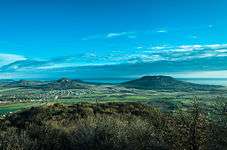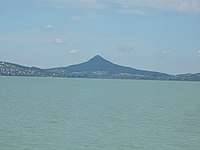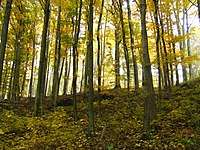Transdanubian Mountains
The Transdanubian Mountains (sometimes also referred to as Bakony Forest, Dunántúl Highlands, Highlands of Dunántúl, Highlands of Transdanubia, Mountains of Dunántúl, Mountains of Transdanubia, Transdanubian Central Range, Transdanubian Hills, Transdanubian Midmountains or Transdanubian Mid-Mountains, Hungarian: Dunántúli-középhegység)[1][2] are a mountain range in Hungary covering about 7000 km². Its highest peak is the Pilis, with a height of 757 m (2,484 ft).
| Transdanubian Mountains | |
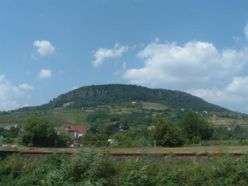 | |
| Badacsony, an isolated mountain in the range. In ancient times, it was an active volcano | |
| Location | Komárom-Esztergom, Fejér, Veszprém, Zala, Pest counties, Hungary |
| Territory | 7,000 km² |
| Highest point | Pilis, 757 m |
| Lowest point | Danube river |
| Terrain | Lower mountains and hills |
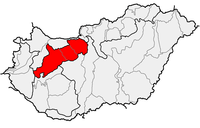
Transdanubian Mountains within physical subdivisions of Hungary
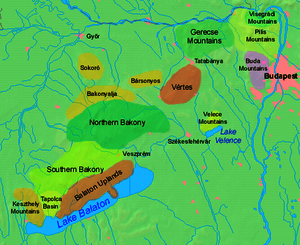
Map of the Transdanubian Mountains
Parts of the mountains
- Bakony
- Southern Bakony
- Northern Bakony
- Vértes Mountains
- Velence Hills
- Dunazug Mountains
Visegrád Mountains are often considered a part of it for geopolitical reasons, but geographically they are part of the North Hungarian Mountains.
Gallery
gollark: I can't provide examples because I don't have access to the information, but your system is *inherently* based on your discretion.
gollark: Technically I'm a teenager.
gollark: Your SYSTEM MAKES IT discretion-based.
gollark: *Not* banning them is discretion-based, at least, although I agree lyric mutes people too much.
gollark: We, at least, actually have a vague code of rules.
References
- Gábor Gercsák (2002). "Hungarian geographical names in English language publications" (PDF). Studia Cartologica. Eötvös Loránd University. Archived from the original (PDF) on 20 March 2012. Retrieved 30 April 2011.
- Gábor Gercsák (2005). "Magyar tájnevek angol fordítása" (PDF). Fasciculi Linguistici / Series Lexicographica (in Hungarian). Eötvös Loránd University. Archived from the original (PDF) on 20 March 2012. Retrieved 30 April 2011.
Sources
- https://www.arcanum.hu/hu
- http://www.karpat-medence.hu (In Hungarian)
This article is issued from Wikipedia. The text is licensed under Creative Commons - Attribution - Sharealike. Additional terms may apply for the media files.

